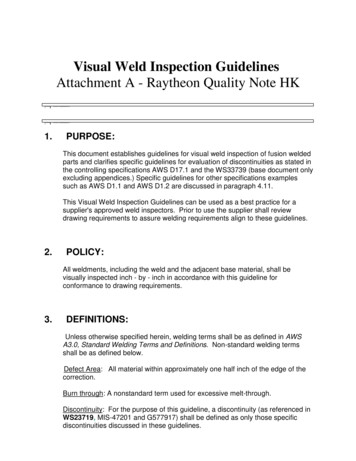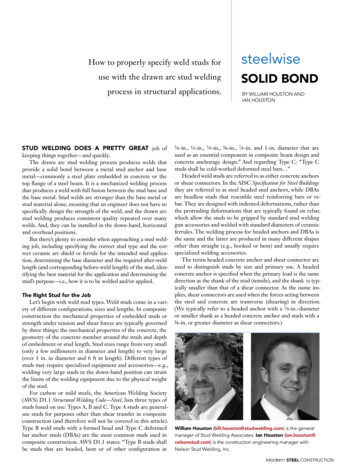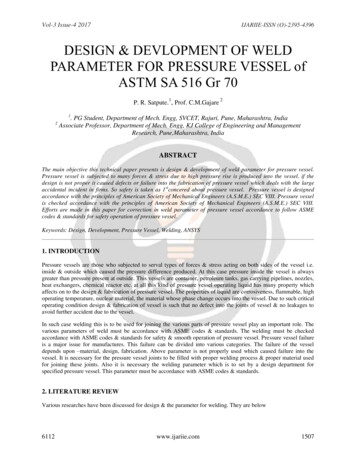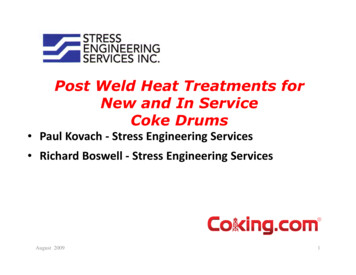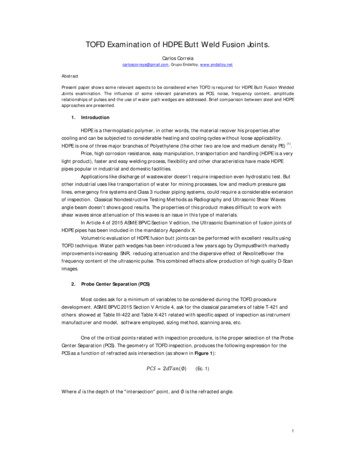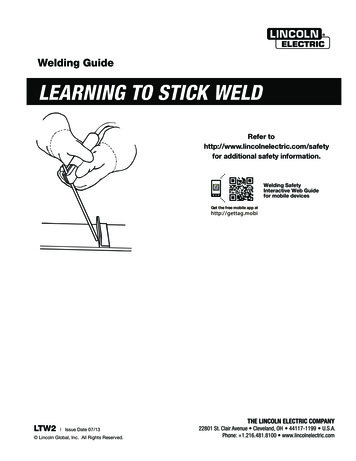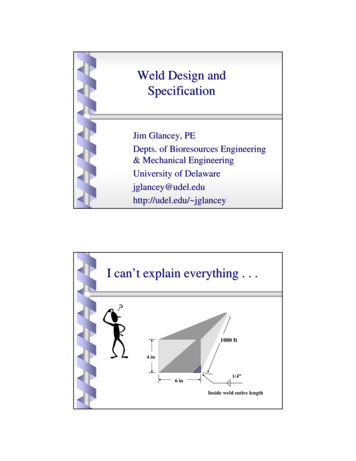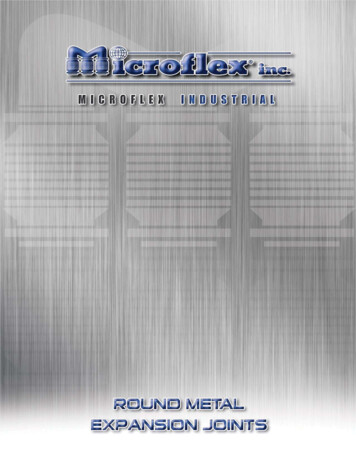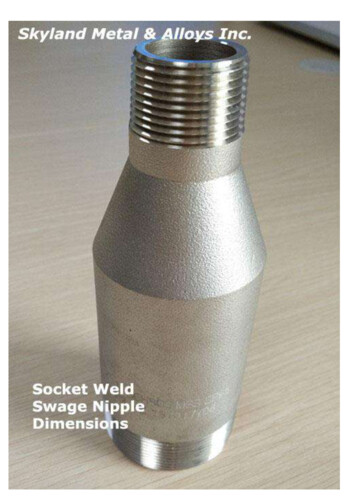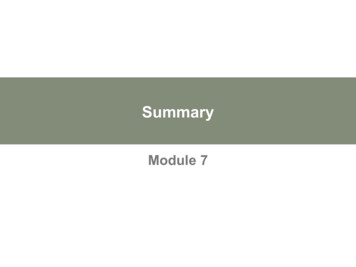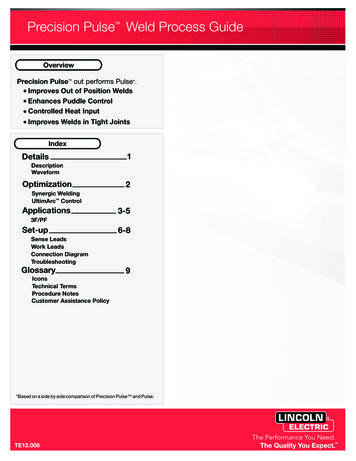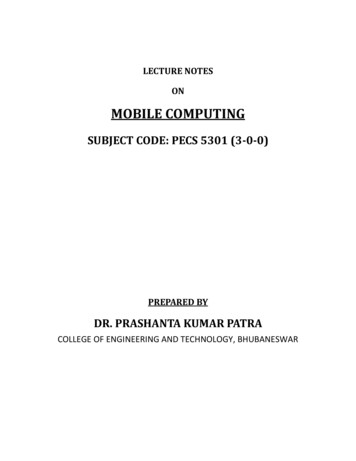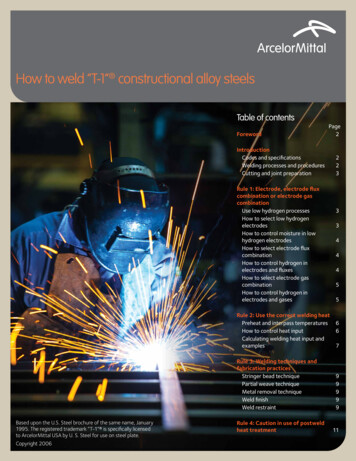
Transcription
How to weld “T-1” constructional alloy steelsTable of contentsForewordIntroduction Codes and specifications Welding processes and procedures Cutting and joint preparationRule 1: Electrode, electrode fluxcombination or electrode gascombination Use low hydrogen processes How to select low hydrogenelectrodes How to control moisture in lowhydrogen electrodes How to select electrode fluxcombination How to control hydrogen inelectrodes and fluxes How to select electrode gascombination How to control hydrogen inelectrodes and gasesPage22233344455Rule 2: Use the correct welding heat Preheat and interpass temperatures 6 How to control heat input6 Calculating welding heat input andexamples7Rule 3: Welding techniques andfabrication practices Stringer bead technique Partial weave technique Metal removal technique Weld finish Weld restraintBased upon the U.S. Steel brochure of the same name, January1995. The registered trademark “T-1” is specifically licensedto ArcelorMittal USA by U. S. Steel for use on steel plate.Copyright 2006Rule 4: Caution in use of postweldheat treatment9999911
How to weld “T-1” constructional alloy steelsForewordThis brochure contains suggestions gathered from research studies andfabrication experiences of our own and of our customers. Thesuggestions are presented as an aid to design, materials, and weldingengineers. The suggestions should not be used for any specificapplication without examination and verification of their suitability forthe application. Procedures suggested in this book should be thoroughlytested to determine that they meet established goals beforeacceptance. Unless otherwise indicated, the terminology used in thisbook is that established by the American Welding Society, ANSI/AWSA3.0-80, Welding Terms and Definitions.The values stated in U.S. customary units are to be regarded asstandard. For use of metric units as a replacement for U.S. customaryunits, refer to AWS A2.3-80, Metric Practice Guide for the WeldingIndustry.“T-1” steels were originally developed by the U.S. Steel Corporation.This brochure is based upon a document of the same name authored byU.S. Steel in January 1995. ArcelorMittal USA facilities has been alicensee of “T-1” steels from USS since 1959. In 2003, the InternationalSteel Group Inc. (now ArcelorMittal USA) purchased the plate assets ofUSS, which included the “T-1” trademark.ArcelorMittal USA assumes no responsibility for, and makes norepresentations or warranties as to, the applicability or suitability of theinformation in this book for any specific application.IntroductionStrength, toughness, ductility, weldability, atmospheric corrosionresistance, economy – these make up the attractive combination ofproperties and characteristics offered to designers and fabricators byArcelorMittal USA “T-1”, “T-1” Type A, “T-1” Type B and “T-1” Type Cconstructional alloy steels.(1) The high yield strength steels, as a group,have a lower tolerance than lower-strength structural steels for zonesof high stress concentration at design details and weld imperfections.Therefore, to obtain maximum advantage of the above-mentionedcharacteristics of the “T-1” steels, it is necessary in their application thattheir higher yield strength be accompanied by refinements in design,workmanship and inspection.Codes and specificationsCodes and specifications recognize the “T-1” steels as ASTM A514 andA517 grades B, F, H, and Q; and ASME SA517 Grades B and F.Designers, fabricators, and users of the “T-1” steels should consider:a.) F or general structural applications, the provisions in the currentedition of the American Welding Society (AWS) D1.1 StructuralWelding Code – Steel;b.) F or bridge applications, the provisions in the current edition ofthe American Association of State Highway and TransportationOfficials (AASHTO) Standard Specifications for WeldingStructural Steel Highway Bridges; and the AASHTO/AWS D1.5Bridge Welding Code.c.) F or pressure-retaining applications, the provisions in the currentedition of the American Society of Mechanical Engineers(ASME) Boiler and Pressure Vessel Code, Section VIII, Division 1(Part UHT) and Division 2 (Part AF, Article F-6).All of the above-mentioned codes and specifications include provisionsfor welding procedure qualification and welder performancequalification, as well as inspection requirements.How to Weld “T-1” Constructional Alloy Steels – Page 2Welding processes and proceduresBecause the ArcelorMittal USA “T-1” steels are different from ordinarycarbon steels, welding practices, while simple are different also. Thesepractices are similar to welding any high yield strength quenched andtempered alloy steel. “T-1” steels can be welded satisfactorily by allmajor welding processes when proper procedures are used. The mostwidely used welding processes are the arc welding processes – shieldedmetal arc welding, submerged arc welding, gas metal arc welding, fluxcored arc welding and gas tungsten arc welding. In welds made by theseprocesses, the cooling from welding is usually so rapid that themechanical properties of the weld approach those of the steel in themill heat treated condition. Thus, reheat treatment (quenching andtempering) of the steel after welding is not necessary.Other welding processes, such as oxyacetylene welding, electroslagwelding, or any process employing multiple arcs, which subject thesteels to excessive heat input and resultant slow cooling from welding,significantly degrade the mechanical properties of the steels. Reheattreatment of steels welded by these processes is necessary.The suitability of the specific welding processes and welding procedureused should be established by the user based on the design application.As with other steels, no welding of “T-1” steels should be done whentemperature in the work place is below 0ºF to minimize the possibilityof poor workmanship.Caution: If reheat treatment after welding is contemplated, contact theArcelorMittal USA plate customer technical service department at 1 610 383 3105 for important information on the effect of such atreatment. It is important to note that this grade of steel may besusceptible to cracking in the heat-affected zone of welds duringpostweld heat treatment (stress relief). Therefore, ArcelorMittal USArecommends that careful consideration be given to this phenomenon bycompetent welding engineers before stress relieving is applied toweldments of this grade. See Rule 4 on page 11 of this document. Also,it is not recommended for service at temperatures lower than –50ºF orhigher than 800ºF.
Cutting and joint preparationCutting and joint preparation of “T-1” steels can be suitably done byoxygen or arc cutting, either manual or mechanized, by practices inaccordance with those suggested in the AWS handbook, latest edition.Such cutting does not require preheating in thicknesses up to andincluding 3 inches, but the steel temperature should not be lower than50ºF during cutting. For thicknesses over 3 inches, a preheattemperature of 300ºF minimum is suggested to minimize the possibilityof edge cracking. Preheat temperatures above 450ºF may result in anexcessively wide heat-affected zone from the thermal cutting andsignificant degradation of mechanical properties in this zone. Whensevere forming is to be done on a plate with a thermal cut edge,removal of the heat-affected zone by grinding or machining is desirableto minimize the possibility of edge cracking from straining of anunremoved heat-affected zone. Refer to the Guidelines for Fabricatingand Processing Plate Steel for additional information on thermal cuttingand forming.(1)Strong reliable welded joints can be readily made in the ArcelorMittalUSA “T-1” steels by following a welding procedure that includes thesefour rules:1 Ugasse combination;the correct electrode, electrode flux combination or electrode2 Use the correct welding heat;3 Use the correct welding techniques and fabrication practices;4 Use care in applying postweld heat treatment (see page 11). For chemical and mechanical properties of “T-1” steels, refer to the ArcelorMittal USA brochure “A514 and “T-1” steels” or the “Plate Steel Specification Guide”.Rule 1: Use the correct electrode, electrode flux combination or electrode gas combinationsUse only welding processes that are suitably controlled to ensurethat they are “low hydrogen”How to select the correct low hydrogen covered electrodes forshielded metal arc weldingHydrogen is the No. 1 enemy of sound welds in alloy steels – andArcelorMittal USA “T-1” steels are alloy steels. In the extremely highheat of welding, any hydrogen introduced into the welding arcatmosphere can be absorbed by the molten weld metal. As the metal inthe joint solidifies, its capacity to hold the hydrogen in solution is greatlyreduced and much of the hydrogen is given off into the air from thesurface of the weld. However, small, but measurable, amounts areretained and can cause hydrogen-induced heat-affected zone crackingor hydrogen-induced weld-metal cracking when the weld cools.Hydrogen-induced cracking – which is not usually visible on the surfaceof the weld – is the most frequent cause of unsound welds in alloysteels.Low hydrogen covered electrodes for shielded metal arc welding areproduced to meet requirements of AWS A5.1(1) (latest edition) or A5.5(2)(latest edition). Electrode classifications are marked on electrodecontainers as well as on individual electrodes. The electrodeclassification system is described in AWS A5.1 and A5.5 and designatesthe weld strength, electrode type and weld metal composition andtoughness. The first two or three digits in the classification indicate theminimum tensile strength of the deposited metal in ksi. The next twodigits designate the type of electrode coating and the applicablewelding current and welding position. A letter or letter digit suffix, whenused, following the digits discussed above indicate a specific chemicalcomposition. Some electrode classifications are also required to meetspecific toughness criteria.For low hydrogen electrodes, the last digit designating the type ofcoating should be 5, 6, or 8. E8015, E9016, E11018 and E7028 areexamples of low hydrogen electrodes that may be used to weldArcelorMittal USA “T-1” steels.An actual weld made to deliberately produce hydrogen-induced cracking bydepositing a weld bead on ArcelorMittal USA “T-1” steel with a Type E6010electrode whose coating inherently has a high hydrogen content. Note theplainly visible crack running almost the entire length of the heat-affected zoneunder the bead.A weld in which hydrogen-induced cracking occurs is not as strong as asound weld – the work pieces are not evenly joined in some placesbecause of the cracking. For example, many welds are subject to forcesthat tend to pull them apart. This means that a weld with hydrogeninduced cracks could fail under a lower force than expected dependingon the extent of cracking.How to Weld “T-1” Constructional Alloy Steels – Page 3For applications where the weld must be as strong as the “T-1” steelsand have similar toughness, use E11018-M electrodes per AWS A5.5(latest edition) capable (depending on welding procedure) of depositingweld metal having a minimum tensile strength of 110 ksi and a CharpyV-notch toughness of 20-ft-lbs. at –60ºF. In some cases, such as for“T-1” Type A Steel in thin sections, it may be necessary to use a higherstrength electrode such as E12018-M in order to meet guided bendtest requirements for welding procedure qualification or welderperformance qualification. The AWS specification limit on maximummoisture content for E100, E110, and E120 classes of electrodes, aswell as the E9018 electrodes, is 5 mml/100gm weld metal diffusiblehydrogen, which is suitable for welding the “T-1” steels.Other electrodes classified by AWS A5.1 or A5.5 depositing weld metaldifferent in strength and toughness may be either necessary orsufficient depending on design stress and application(3). For example,electrodes that deposit weld metal lower in strength (E100, E90, E80and E70 classes) than that of the “T-1” steels are often adequate,
depending on design stress such as for fillet welds in longitudinal shear;furthermore, lower strength weld metal is frequently desirable toreduce the chance of cracking in highly restrained fillet welds or groovewelds in tee or corner joints. When welding a “T-1” steel to a steel gradeof lower strength, the electrode strength steel may be as low as thatsuitable for the lower strength steel. When electrodes lower in strengththan E100, E110 or E120 classes are used to weld a “T-1” steel, suchlower strength electrodes should be baked as discussed in the followingsection. This is necessary to assure that the diffusible hydrogen doesnot exceed 5 ml/100 gm since the AWS specification limits onmaximum moisture content for E70, E80 and some E90 classelectrodes exceed 5 ml/100 gm.How to control moisture in low hydrogen covered electrodes andhydrogen in weld metalWhen exposed to air, low hydrogen electrodes may pick up excessivemoisture. Such moisture-contaminated electrodes are sources ofhydrogen that can generate heat-affected zone or weld metal crackingeven though the electrodes are classified as low hydrogen. Once theelectrode container has been opened, it is essential that the followingprecautions be taken to keep the electrodes suitably dry:1. I f the electrodes are in a hermetically sealed container,immediately upon opening the container, put the electrodes intoa ventilated holding oven at 250-300ºF.2. I f the electrode container has been damaged so as to allow entryof air or if it is a type of container that is not hermetically sealed(such as cardboard box), the electrodes must be properly driedto reduce the moisture to less than 0.2 percent. Check with theelectrode manufacturer for the correct temperature and time touse. One, to one-and-a-quarter, hours at 800ºF is common. Besure the oven is vented for air circulation. Dried electro
produced to meet requirements of AWS A5.1(1) (latest edition) or A5.5(2) (latest edition). Electrode classifications are marked on electrode containers as well as on individual electrodes. The electrode classification system is described in AWS A5.1 and A5.5 and designates the weld strength, electrode type and weld metal composition and toughness. The first two or three digits in the classification indicate the
